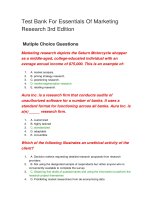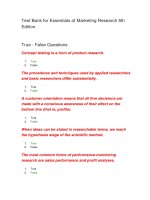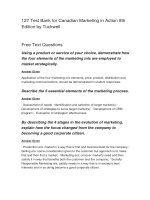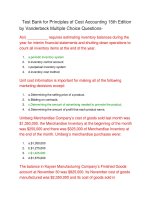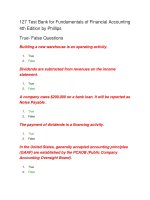Test bank for anatomy of orofacial structures 8th edition by brand
Bạn đang xem bản rút gọn của tài liệu. Xem và tải ngay bản đầy đủ của tài liệu tại đây (630.3 KB, 9 trang )
Chapter 01: Oral Cavity
Brand/Isselhard: Anatomy of Orofacial Structures, 8th Edition
MULTIPLE CHOICE
1. A diastema is a space between two teeth in the same arch. When this occurs between the maxillary central incisors, it is often the
result of a pronounced labial frenum.
a. Both statements are true.
b. The first statement is true; the second statement is false.
c. The first statement is false; the second statement is true.
d. Both statements are false.
ANS: A
A space, or lack of contact area, between any two teeth in the same arch is called a diastema. When a diastema occurs between the
maxillary central incisors, it is often the result of a pronounced labial frenum extending to the crest of the alveolar ridge and
possibly over the ridge. This band of firm connective tissue causes the erupting incisors to be pushed aside resulting in a diastema,
or space. Correction of a diastema usually involves surgical removal, or cutting, of the frenal tissue between teeth.
REF: p. 3
OBJ: To describe the boundaries and sub-boundaries of the oral cavity and the structures in each area
NAT: CDA: GC I.A.6. Identify basic oral anatomy and physiology, including but not limited to: oral cavity.
General dental anatomy
TOP: BLOOM: Remembering
STA:
NBDHE: SB 1.1.2.1.
2. Torus palatinus is seen on the
a. soft palate
b. hard palate
c. alveolar ridge
d. oral pharynx
Test Bank for Anatomy of Orofacial Structures 8th Edition By Bran
ANS: B
Torus palatinus is excess bone growth and occurs in the midline of the hard palate. It may grow to varying sizes and is generally
only a problem when the construction of a maxillary denture is necessary. In health, such bony protuberances, or excess bone
growths, do not occur on the soft palate, alveolar ridge, or oral pharynx.
REF: p. 5
OBJ: To define the terms vestibule, oral cavity proper, mucobuccal fold, frenum, alveolar mucosa, gingiva, exostoses, torus palatinus, and
torus mandibularis
NAT: CDA: GC I.A.2. Identify basic oral anatomy and physiology, including but not limited to: bones. STA: NBDHE: SB 1.1.2.1. General
dental anatomy
TOP: BLOOM: Remembering
3. Contraction of which muscle raises the tongue upward?
a. Mylohyoid
b. Palatopharyngeal
c. Palatoglossal
d. Levator glossal
ANS: A
Contraction of the mylohyoid muscle raises the tongue. The palatopharyngeal muscle and the palatoglossal muscle form the
posterolateral borders of the oral cavity. There is not a muscle by the name of levator glossal.
REF: p. 7
OBJ: To define the landmarks in the floor of the mouth and the hard and soft palate and the structures that form them
NAT: CDA: GC I.A.4. Identify basic oral anatomy and physiology, including but not limited to: muscles.
STA:
General dental anatomy
TOP: BLOOM: Remembering
NBDHE: SB 1.1.2.1.
4. The oral vestibule is partially bordered by the lips and cheeks. The oral cavity proper extends posteriorly to the soft palate.
a. Both statements are true.
b. The first statement is true; the second statement is false.
c. The first statement is false; the second statement is true.
d. Both statements are false.
ANS: B
The oral vestibule is the space or potential space that exists between the lips or cheeks and teeth. In an edentulous person, the
vestibule would extend between the lips or cheeks and the alveolar ridges. The oral cavity proper is surrounded by teeth or alveolar
ridges and extends all the way back to the palatine tonsils. This includes the region from the floor of the mouth upward to the hard
and soft palates.
REF: p. 2
OBJ: To describe the boundaries and sub-boundaries of the oral cavity and the structures in each area
NAT: CDA: GC I.A.6. Identify basic oral anatomy and physiology, including but not limited to: oral cavity.
General dental anatomy
TOP: BLOOM: Remembering
Copyright © 2019, Elsevier Inc. All Rights Reserved.
Full file at />
STA:
NBDHE: SB 1.1.2.1.
1
5. Each of the following is true of the uvula EXCEPT one. Which one is the EXCEPTION?
a. It is located at the most posterior portion of the hard palate.
b. It is located at the midline.
c. It is a downwardly projecting muscle.
d. It is necessary for swallowing.
ANS: D
The uvula is a downwardly projecting muscular tissue located at the midline of the most posterior portion of the hard palate. It is
NOT necessary for swallowing.
REF: p. 6
OBJ: To define the landmarks in the floor of the mouth and the hard and soft palate and the structures that form them
NAT: CDA: GC I.A.6. Identify basic oral anatomy and physiology, including but not limited to: oral cavity.
STA:
General dental anatomy
TOP: BLOOM: Remembering
NBDHE: SB 1.1.2.1.
6. The circumvallate papillae are located on the hard palate, buccal mucosa, and floor of the mouth. The papillae found on the tongue
are the filiform, fungiform, vallate, foliate, and incisive.
a. Both statements are true.
b. The first statement is true; the second statement is false.
c. The first statement is false; the second statement is true.
d. Both statements are false.
ANS: D
All papillae listed in both statements are located on the tongue with the exception of the incisive papilla, which is located on the
hard palate. Note that the incisive papilla is a singular structure, thus the different spelling. There are no papillae located on either
the buccal mucosa or the floor of the mouth.
REF: p. 7
OBJ: To define the landmarks in the floor of the mouth and the hard and soft palate and the structures that form them
NAT: CDA: GC I.A.6.
Identify
anatomy and
but not8th
limited
to: oral By
cavity.
Test
Bankbasic
fororal
Anatomy
of physiology,
Orofacialincluding
Structures
Edition
Bran STA:
General dental anatomy
TOP: BLOOM: Remembering
NBDHE: SB 1.1.2.1.
7. Each of the following structures can readily be viewed when examining the oral cavity EXCEPT one. Which one is the
EXCEPTION?
a. Fovea palatinae
b. Tonsillar pillars
c. Laryngeal pharynx
d. Sublingual fold
ANS: C
The laryngeal pharynx is located below the oral pharynx and cannot be seen while examining the oral cavity. The fovea palatinae,
the tonsillar pillars, and the sublingual fold can be seen when examining the oral cavity. Fovea palatinae are small depressions in
mucosa on either side of the posterior nasal spine indicating the junction of the hard and soft palate. Tonsillar pillars are folds of
tissue that partially surround the tonsils. The sublingual fold extends backward on either side of the floor of the mouth and is
situated just superior to the submandibular gland.
REF: p. 2 | pp. 6-7
OBJ: To describe the boundaries and sub-boundaries of the oral cavity and the structures in each area
NAT: CDA: GC I.A.6. Identify basic oral anatomy and physiology, including but not limited to: oral cavity.
General dental anatomy
TOP: BLOOM: Remembering
STA:
NBDHE: SB 1.1.2.1.
8. Each of the following structures is located within the hard palate EXCEPT one. Which one is the EXCEPTION?
a. Incisive papilla
b. Rugae
c. Greater palatine foramina
d. The anterior and posterior pillars
ANS: D
The anterior and posterior pillars are located posterior to the soft palate. The posterior pillar is also called the pal atopharyngeal arch
or fold. The anterior pillar is also called the palatoglossal arch or fold. The tonsils lie between the anterior and posterior pillars.
The incisive papilla and rugae are located on the anterior portion of the hard palate. The greater palatine foramina are located in the
posterior portions of the hard palate lingual to the second and third maxillary molars.
REF: pp. 5-6
OBJ: To define the landmarks in the floor of the mouth and the hard and soft palate and the structures that form them
NAT: CDA: GC I.A.6. Identify basic oral anatomy and physiology, including but not limited to: oral cavity.
STA:
General dental anatomy
TOP: BLOOM: Remembering
Copyright © 2019, Elsevier Inc. All Rights Reserved.
Full file at />
NBDHE: SB 1.1.2.1.
2
9. The small bony growths that commonly occur on the buccal cortical plate of the maxillae and the mandible are called
a. torus palatinus
b. mandibular tori
c. exostoses
d. maxillary tuberosity
ANS: C
Exostoses, small bony growths that occur on the buccal cortical plate on the mandible and the maxillae, are seen in a large portion
of the population. They are normally inconsequential unless they become tender or a denture is needed. Exostoses occur more
frequently on the mandible than on the maxillae.
Torus palatinus are excess bony growths that commonly occur in the midline of the palate. Mandibular tori are bony swellings that
frequently occur on the lingual surface of the mandible at the canine area. The maxillary tuberosity is a rounded bony protrusion in
the area of the third molar.
REF: p. 4
OBJ: To define the terms vestibule, oral cavity proper, mucobuccal fold, frenum, alveolar mucosa, gingiva, exostoses, torus palatinus, and
torus mandibularis
NAT: CDA: GC I.A.2. Identify basic oral anatomy and physiology, including but not limited to: bones. STA: NBDHE: SB 1.1.2.1. General
dental anatomy
TOP: BLOOM: Remembering
10. Which structure is the MOST vascular in appearance?
a. Mucogingival junction
b. Alveolar mucosa
c. Labial frenum
d. Gingiva
ANS: B
The alveolar mucosa, a thin layer of loosely attached and movable tissue, covers a highly vascular area. The presence of blood
vessels immediately under this relatively thin mucosa is responsible for the general reddish color. By contrast, the mucogingival
junction that divides the attached gingiva from the alveolar mucosa appears more pink in color. The gingiva and labial frenum also
appear pink in color.
REF: p. 2
OBJ: To define the terms vestibule, oral cavity proper, mucobuccal fold, frenum, alveolar mucosa, gingiva, exostoses, torus palatinus, and
torus mandibularis
NAT: CDA: GC I.A.6. Identify basic oral anatomy and physiology, including but not limited to: oral cavity.
STA: NBDHE: SB 1.1.2.1.
General dental anatomy
TOP: BLOOM: Remembering
11. Although a patient presenting with painful areas throughout the oral cavity or a child presenting with gingival bleeding in the
presence of excellent oral hygiene should be monitored carefully, referral to a dental specialist or physician is not indicated. A
patient with a red and painful tongue does warrant such a referral as does a patient with moderate plaque on all teeth.
a. Both statements are true.
b. The first statement is true; the second statement is false.
c. The first statement is false, the second statement is true.
d. Both statements are false.
ANS: D
Of the four situations presented in this two-part question, only the patient with moderate plaque on all teeth does NOT warrant
referral to a specialist. This patient should receive appropriate oral hygiene instructions, oral debridement, and be carefully
monitored with short re-care appointments. The remaining three oral conditions described in the question describe conditions
suggestive of systemic involvement and warrant further investigation, typically referral to a dental specialist or physician. In
particular, gingival bleeding in the presence of excellent oral hygiene is a possible early sign of leukemia.
REF:
OBJ:
NAT:
STA:
TOP:
p. 8
To differentiate normal from abnormal anatomy in the oral cavity and to ensure a follow-up examination
CDA: GC I.A.1. Identify basic oral and dental anatomy, physiology and development, including but not limited to: oral ca vity.
NBDHE: SB 1.1.2.1. General dental anatomy
BLOOM: Analyzing
12. Which structure is most closely located to the lingual frenum?
a. Sublingual caruncle
b. Sublingual salivary gland
c. Sublingual fold
d. Lingual tonsils
e. All of the above
ANS: A
The sublingual caruncle, a small elevation on each side of the base of the lingual frenum, is the opening for the submandibular and
sublingual salivary glands. Of the structures provided in the question, it is located most closely to the lingual frenum. The
sublingual fold extends posteriorly from the sublingual caruncle. The lingual tonsils are located at the base of the tongue.
REF: p. 7
OBJ: To define the landmarks in the floor of the mouth and the hard and soft palate and the structures that form them
NAT: CDA: GC I.A.6. Identify basic oral anatomy and physiology, including but not limited to: oral cavity.
STA:
General dental anatomy
TOP: BLOOM: Remembering
Copyright © 2019, Elsevier Inc. All Rights Reserved.
Full file at />
NBDHE: SB 1.1.2.1.
3
13. The term for misplaced sebaceous glands occurring in the oral cavity is rugae. These harmless, yellowish granular structures occur
in about 60% to 80% of the population.
a. Both statements are true.
b. The first statement is true; the second statement is false.
c. The first statement is false; the second statement is true.
d. Both statements are false.
ANS: C
Fordyce granules are misplaced sebaceous glands found in the oral cavity. These glands are normally associated with hair follicles,
which are normally located in the skin. The most common locations for Fordyce granules are the lips, cheeks, and retromolar pads.
Rugae are hard transverse ridges of epithelial and connective tissue located in the anterior portion of the hard palate.
REF: p. 5
OBJ: To differentiate normal from abnormal anatomy in the oral cavity and to ensure a follow-up examination
NAT: CDA: GC I.A.6. Identify basic oral anatomy and physiology, including but not limited to: oral cavity.
General dental anatomy
TOP: BLOOM: Remembering
STA:
NBDHE: SB 1.1.2.1.
14. Of the following structures, which is the MOST susceptible to trauma?
a. Hard palate
b. Buccal mucosa
c. Floor of the mouth
d. Dorsal surface of the tongue
e. Attached gingiva
ANS: C
Although any oral tissue may be traumatized, the tissue in the floor of the mouth is one of the thinnest and thus very conducive to
trauma. The hard palate and the attached gingiva have a more protective, fibrous nature. The dorsal (top) tongue and the buccal
mucosa also have more protective features than does the mucosal lining on the floor of the mouth. Not listed as a selection, the
ventral (lower) surface of the tongue is quite vulnerable to trauma.
REF: p. 7
OBJ: To define the landmarks in the floor of the mouth and the hard and soft palate and the structures that form them
NAT: CDA: GC I.A.6. Identify basic oral anatomy and physiology, including but not limited to: oral cavity.
STA:
General dental anatomy
TOP: BLOOM: Remembering
NBDHE: SB 1.1.2.1.
15. A generally healthy man in his forties is curious about “little raised yellow spots” on his buccal mucosa. He has noticed them in the
past but they do not seem to cause problems or become larger, so has not previously asked about them. These areas are MOST
likely
a. vallate papillae
b. Kaposi’s spots
c. Fordyce granules
d. measles
ANS: C
Fordyce granules are ectopic, or misplaced, sebaceous glands that occur on oral mucosal surfaces. They appear as small raised
yellowish or whitish spots. Although alarming to patients, these formations are harmless. Vallate papillae, also called circumvallate
papillae, are the large V-shaped row of taste buds located on the posterior dorsum of the tongue. Kaposi’s spots, associated with
immunodeficiency, are red and painful. Measles can appear anywhere on the body, including the oral cavity, and are red in color.
REF: p. 4
OBJ: To differentiate normal from abnormal anatomy in the oral cavity and to ensure a follow-up examination
NAT: CDA: GC I.A.3. Identify basic oral anatomy and physiology, including but not limited to: glands/lymphatics.
1.1.2.1. General dental anatomy
TOP: BLOOM: Understanding
STA:
NBDHE: SB
16. Fordyce granules normally function as
a. taste buds
b. a characteristic of a malignancy
c. sebaceous glands
d. an infectious viral illness
ANS: C
Fordyce granules are misplaced sebaceous glands that appear as very small yellowish granular structures on oral mucosal surfaces
in the oral cavity of 60% to 80% of the population. Sebaceous glands normally occur in the skin; when they are present in the oral
cavity they are considered misplaced, or ectopic. Although Fordyce granules may be alarming to patients, they are harmless. They
most commonly occur in the mucosa of the lips, cheeks, retromolar pads, and gingival tissues.
REF: p. 4
OBJ: To differentiate normal from abnormal anatomy in the oral cavity and to ensure a follow-up examination
NAT: CDA: GC I.A.3. Identify basic oral anatomy and physiology, including but not limited to: glands/lymphatics.
1.1.2.1. General dental anatomy
TOP: BLOOM: Remembering
Copyright © 2019, Elsevier Inc. All Rights Reserved.
Full file at />
STA:
NBDHE: SB
4
17. In the following illustration, structure “a” is the
a.
b.
c.
d.
mucobuccal fold
maxillary labial frenum
mandibular labial frenum
mucogingival junction
ANS: B
At the midline of the upper lip, a fold of connective tissue known as the maxillary labial frenum can be found. A corresponding
structure, the mandibular labial frenum, is present at the midline of the lower lip. The upper frenum is usually more pronounced
than the lower. Both structures, as well as additional less well-defined frena, serve to attach the lips to the arch and contain only
connective tissue. Structure “b” is the mandibular labial frenum. Structure “c” is the mucogingival junction. Structure “d” is the
mucobuccal fold.
REF: pp. 3-4
OBJ: To define the terms vestibule, oral cavity proper, mucobuccal fold, frenum, alveolar mucosa, gingiva, exostoses, torus palatinus, and
torus mandibularis
NAT: CDA: GC I.A.6. Identify basic oral anatomy and physiology, including but not limited to: oral cavity.
STA: NBDHE: SB 1.1.2.1.
General dental anatomy
Test Bank for Anatomy of Orofacial Structures 8th Edition By Bran
TOP: BLOOM: Remembering
18. In the following illustration, structure “b” is the
a.
b.
c.
d.
mucobuccal fold
mucogingival junction
maxillary labial frenum
mandibular labial frenum
ANS: D
At the midline of the lower lip, a fold of connective tissue known as the mandibular labial frenum can be found. A mandibular
frenal attachment that extends too close to the gingiva may contribute to gingival recession. A corresponding structure, the
maxillary labial frenum, is present at the midline of the upper lip. Both structures, as well as additional less well-defined frena,
serve to attach the lips to the arch and contain only connective tissue. Structure “a” is the maxillary labial frenum. Structure “c” is
the mucogingival junction. Structure “d” is the mucobuccal fold.
REF: pp. 3-4
OBJ: To define the terms vestibule, oral cavity proper, mucobuccal fold, frenum, alveolar mucosa, gingiva, exostoses, torus palatinus, and
torus mandibularis
NAT: CDA: GC I.A.6. Identify basic oral anatomy and physiology, including but not limited to: oral cavity.
STA: NBDHE: SB 1.1.2.1.
General dental anatomy
TOP: BLOOM: Remembering
Copyright © 2019, Elsevier Inc. All Rights Reserved.
Full file at />
5
19. In the following illustration, structure “c” is the
a.
b.
c.
d.
mucogingival junction
mandibular labial frenum
maxillary labial frenum
mucobuccal fold
ANS: A
The mucogingival junction is the demarcation between the attached gingiva and the more loosely connected alveolar mucosa. A
change in tissue color is evident at the mucogingival junction. The attached gingiva is pink in color whereas the alveolar mucosa is
considerably more red. Structure “a” is the maxillary labial frenum. Structure “b” is the mandibular labial frenum. Structure “d” is
the mucobuccal fold.
REF: pp. 3-4
OBJ: To describe the boundaries and sub-boundaries of the oral cavity and the structures in each area
NAT: CDA: GC I.A.6. Identify basic oral anatomy and physiology, including but not limited to: oral cavity.
General dental anatomy
TOP: BLOOM: Remembering
Test Bank
for Anatomy
structure
“d” is the
20. In the following illustration,
STA:
NBDHE: SB 1.1.2.1.
of Orofacial Structures 8th Edition By Bran
Full file at />
a.
b.
c.
d.
mandibular labial frenum
mucogingival junction
mucobuccal fold
maxillary labial frenum
ANS: C
The point at which the mucosa of the lips or cheeks joins the gingival tissue is known as the mucobuccal fold or mucolabial fold.
These structures are generally located slightly distal to the canine teeth and are quite evident. Structure “a” is the m axillary labial
frenum. Structure “b” is the mandibular labial frenum. Structure “c” is the mucogingival junction.
REF: pp. 3-4
OBJ: To define the terms vestibule, oral cavity proper, mucobuccal fold, frenum, alveolar mucosa, gingiva, exostoses, torus palatinus, and
torus mandibularis
NAT: CDA: GC I.A.6. Identify basic oral anatomy and physiology, including but not limited to: oral cavity.
STA: NBDHE: SB 1.1.2.1.
General dental anatomy
TOP: BLOOM: Remembering
Copyright © 2019, Elsevier Inc. All Rights Reserved.
Full file at />
6
21. In the following illustration, structure “a” is the
a.
b.
c.
sublingual fold
lingual frenum
sublingual caruncle
ANS: B
The lingual frenum, also called the lingual frenulum, extends from an area near the tip of the ventral surface of the tongue to the
floor of the mouth. If this frenum is attached close to the tip of the tongue and is rather short, the tongue movement will be limited
resulting in a condition called ankyloglossia, or tongue tie. In the illustration, structure “b” is the sublingual fold; structure “c” is
the sublingual caruncle.
REF: p. 7
OBJ: To define the terms vestibule, oral cavity proper, mucobuccal fold, frenum, alveolar mucosa, gingiva, exostoses, torus palatinus, and
torus mandibularis
NAT: CDA: GC I.A.6. Identify basic oral anatomy and physiology, including but not limited to: oral cavity.
STA: NBDHE: SB 1.1.2.1.
General dental anatomy
TOP: BLOOM: Remembering
22. In the following illustration, structure “b” is the
Test Bank for Anatomy of Orofacial Structures 8th Edition By Bran
Full file at />
a.
b.
c.
sublingual fold
lingual frenum
sublingual caruncle
ANS: A
The sublingual fold, a bilateral formation, extends from the sublingual caruncle and runs back along the floor of the mouth. In the
illustration structure “a” is the lingual frenum; structure “c” is the sublingual caruncle.
REF: p. 7
OBJ: To define the landmarks in the floor of the mouth and the hard and soft palate and the structures that form them
NAT: CDA: GC I.A.6. Identify basic oral anatomy and physiology, including but not limited to: oral cavity.
STA:
General dental anatomy
TOP: BLOOM: Remembering
NBDHE: SB 1.1.2.1.
23. In the following illustration, structure “c” is the
a.
b.
c.
sublingual fold
sublingual caruncle
lingual frenum
ANS: B
The sublingual caruncle is the opening for the ducts of the submandibular and sublingual salivary glands. It is a small elevation
located at the base of each side of the lingual frenum. Structure “a” is the lingual frenum. Structure “b” is the sublingual fold.
REF: p. 7
OBJ: To define the terms vestibule, oral cavity proper, mucobuccal fold, frenum, alveolar mucosa, gingiva, exostoses, torus palatinus, and
torus mandibularis
NAT: CDA: GC I.A.6. Identify basic oral anatomy and physiology, including but not limited to: oral cavity.
STA: NBDHE: SB 1.1.2.1.
General dental anatomy
TOP: BLOOM: Remembering
Copyright © 2019, Elsevier Inc. All Rights Reserved.
Full file at />
7
TRUE/FALSE
1. The nasopalatine nerves and blood vessels travel through the incisive papilla.
ANS: F
The nasopalatine nerves and blood vessels travel through the incisive foramen as they innervate and deliver nutrients to the mucous
membrane lingual to the maxillary incisor teeth. The incisive papilla, a singular bulge of tissue at the midline immediately posterior
to the central incisors, is located just above the incisive foramen. The incisive papilla is a point of injection for anesthetizing the
anterior palate between the canines.
REF: p. 5
OBJ: To define the landmarks in the floor of the mouth and the hard and soft palate and the structures that form them
NAT: CDA: GC I.A.1. Identify basic oral anatomy and physiology, including but not limited to: blood vessels. STA:
General dental anatomy
TOP: BLOOM: Remembering
NBDHE: SB 1.1.2.1.
2. Beneath the incisive papilla is an injection site called the greater palatine foramen.
ANS: F
Beneath the incisive papilla is the incisive foramen, which carries the nasopalatine nerves and blood vessels to the mucous
membrane lingual to the maxillary incisor teeth. The incisive foramen is a point of injection for anesthetizing the anterior palate
area between the canines. The greater palatine foramen, which serves as a landmark for local anesthesia, is located on the posterior
portion of the hard palate adjacent to the maxillary second and third molars.
REF: p. 5
OBJ: To define the landmarks in the floor of the mouth and the hard and soft palate and the structures that form them
NAT: CDA: GC I.A.6. Identify basic oral anatomy and physiology, including but not limited to: oral cavity.
STA:
General dental anatomy
TOP: BLOOM: Remembering
of the
softfor
palate
is a part ofofthe
esophagus.Structures
3. The posterior portion
Test
Bank
Anatomy
Orofacial
ANS: F
NBDHE: SB 1.1.2.1.
8th Edition By Bran
Full file at />
Most of the posterior portion of the soft palate is part of the oral pharynx. Food reaches the esophagus AFTER passing both the oral
pharynx and laryngeal pharynx.
REF: p. 6
OBJ: To define the landmarks in the floor of the mouth and the hard and soft palate and the structures that form them
NAT: CDA: GC I.A.6. Identify basic oral anatomy and physiology, including but not limited to: oral cavity.
STA:
General dental anatomy
TOP: BLOOM: Remembering
NBDHE: SB 1.1.2.1.
4. Projections on the cortical plate are exostoses of bone.
ANS: T
Exostoses are small, bony growths located on the cortical plate of the mandible and maxillae. They generally occur more frequently
on the mandible than on the maxilla. Exostoses are normally of no consequence unless they become tender from toothbrushing or if
dentures are being constructed.
REF: p. 4
OBJ: To differentiate normal from abnormal anatomy in the oral cavity and to ensure a follow-up examination
NAT: CDA: GC I.A.2. Identify basic oral anatomy and physiology, including but not limited to: bones. STA:
dental anatomy
TOP: BLOOM: Remembering
NBDHE: SB 1.1.2.1. General
5. The indentation at the midline above the upper lip is called the philtrum.
ANS: T
The philtrum, derived from the embryonic nasal processes, is an indentation at the midline of the upper lip. It is at the lateral
junction of the philtrum that a cleft lip might be formed.
REF: p. 2
OBJ: To describe the boundaries and sub-boundaries of the oral cavity and the structures in each area
NAT: CDA: GC I.A.6. Identify basic oral anatomy and physiology, including but not limited to: oral cavity.
General dental anatomy
TOP: BLOOM: Remembering
STA:
NBDHE: SB 1.1.2.1.
6. Lymphoid tissues located at the base of the tongue are known as foliate papillae.
ANS: F
Enlargements of lymphoid tissue located at the base of the tongue are collectively known as lingual tonsils. Rudimentary foliate
papillae are located on the lateral surfaces of the tongue. Both lingual tonsils and foliate papillae should be carefully examined
because their location makes them difficult to see and might hide early signs of oral cancer.
REF: p. 7
OBJ: To differentiate normal from abnormal anatomy in the oral cavity and to ensure a follow-up examination
NAT: CDA: GC I.A.3. Identify basic oral anatomy and physiology, including but not limited to: glands/lymphatics.
1.1.2.1. General dental anatomy
TOP: BLOOM: Remembering
Copyright © 2019, Elsevier Inc. All Rights Reserved.
Full file at />
STA:
NBDHE: SB
8
7. The ridge of bone that can be palpated in the upper posterior aspect of the vestibular space is referred to as the vestibular
zygomaticoalveolar crest.
ANS: T
The zygomaticoalveolar crest is a ridge of bone that marks the beginning of the anterior part of the zygomatic arch (cheek bone)
and can be palpated by running the finger along the upper posterior vestibular space.
REF: p. 2
OBJ: To describe the boundaries and sub-boundaries of the oral cavity and the structures in each area
NAT: CDA: GC I.A.6. Identify basic oral anatomy and physiology, including but not limited to: oral cavity.
General dental anatomy
TOP: BLOOM: Remembering
STA:
NBDHE: SB 1.1.2.1.
Test Bank for Anatomy of Orofacial Structures 8th Edition By Bran
Full file at />
Copyright © 2019, Elsevier Inc. All Rights Reserved.
Full file at />
9




